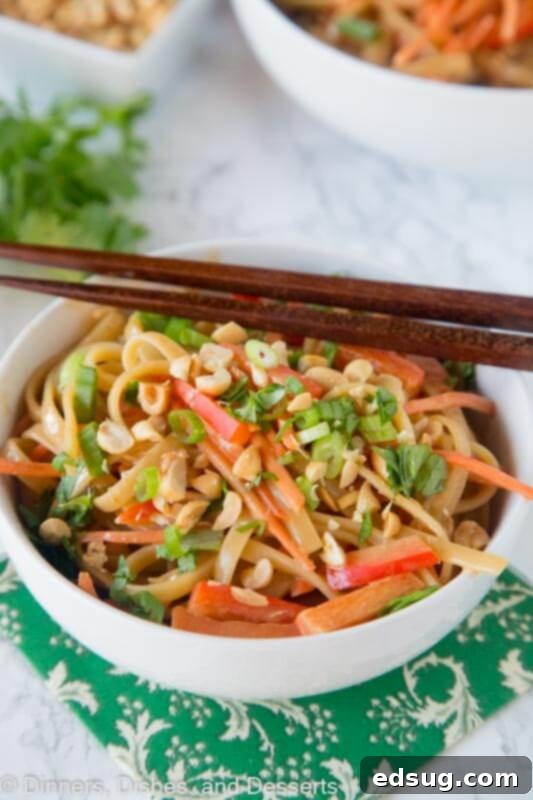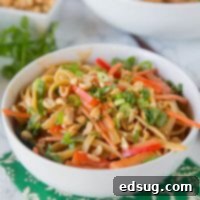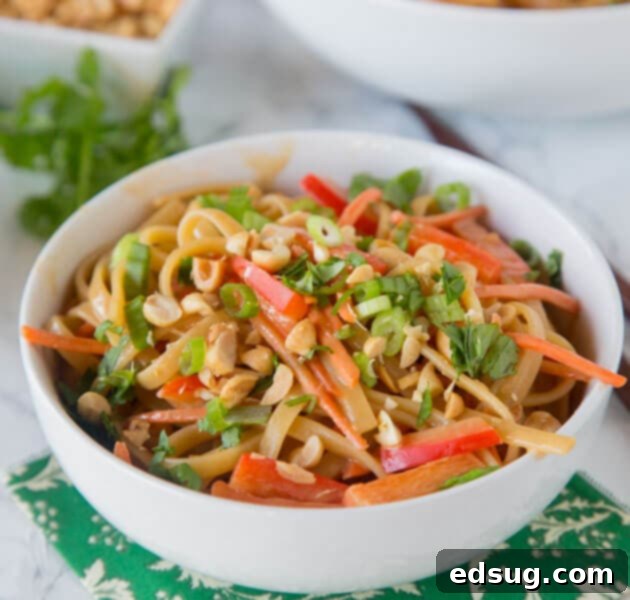Easy & Creamy Thai Peanut Noodles: A Flavorful Weeknight Meal
Indulge in the irresistible flavors of super easy Asian noodles generously coated in a rich, creamy peanut butter sauce, vibrant bell peppers, and crisp carrots. This quick and customizable dish is perfect for any weeknight!
There’s something incredibly satisfying about a bowl of Asian-style noodles, isn’t there? Lately, I’ve found myself with a serious obsession, and it seems many of you share this love! Recipes like our Garlic Beef Noodle Bowls have become incredibly popular on the site. Building on that enthusiasm, I’m thrilled to share a delightful Thai-inspired twist on noodles that I’m sure you’ll adore.
This particular recipe is designed to be a delicious, meat-free option, making it wonderfully quick and light. However, don’t fret if you’re looking for something heartier! I’ve included plenty of suggestions for adding your favorite proteins and a wider array of vegetables to ensure this dish is filling and satisfying for everyone at your table.

Why You’ll Adore This Thai Peanut Noodle Recipe
Beyond being incredibly tasty, these Thai Peanut Noodles offer a range of benefits that make them a fantastic addition to your recipe rotation:
- Lightning Fast: From start to finish, this meal can be on your table in just 15 minutes, making it ideal for busy weeknights.
- Highly Customizable: Whether you’re vegetarian, a meat-lover, or have specific dietary preferences, this recipe easily adapts to your needs. Add different proteins, experiment with various vegetables, or adjust the spice level to your liking.
- Packed with Flavor: The star of the show is the rich, creamy peanut sauce—a perfect blend of savory, sweet, and a hint of tang, with a touch of ginger and garlic that elevates every bite.
- Budget-Friendly: Made with common pantry staples and affordable fresh ingredients, this dish is kind to your wallet without compromising on taste.
- Perfect for Meal Prep: These noodles taste just as good the next day, hot or cold, making them excellent for lunchboxes or quick future meals.
Essential Ingredients for Your Thai Peanut Noodles
Creating this flavorful dish requires a handful of simple ingredients, many of which you likely already have on hand. Here’s a detailed look at what you’ll need to gather:
- Noodles: The foundation of our dish! We’ll dive deeper into noodle choices below, but whether it’s ramen, linguine, or rice noodles, pick your favorite.
- Fresh Carrots: Adds a touch of sweetness and a lovely crunch. Shredded carrots blend beautifully into the dish.
- Bell Peppers: Not only do they add vibrant color, but bell peppers also provide a refreshing crisp texture and mild sweetness. Any color works!
For the Irresistible Peanut Sauce:
- Creamy Peanut Butter: The heart of the sauce, providing its characteristic richness and nutty flavor. Opt for creamy for the smoothest sauce, but natural or even a little crunchy can work if you don’t mind a slightly different texture.
- Water: Helps thin the sauce to the perfect consistency, ensuring it coats the noodles beautifully.
- Soy Sauce: Adds the essential savory, umami depth. Low-sodium soy sauce is a great option if you’re watching your sodium intake.
- Honey: Balances the savory and tangy notes with natural sweetness. Maple syrup or brown sugar can be used as alternatives.
- Rice Vinegar: Provides a crucial touch of acidity and tang, brightening all the flavors in the sauce.
- Fresh Ginger: Grated fresh ginger brings a warm, zesty, and aromatic punch that is classic in Thai-inspired dishes.
- Garlic: Finely minced fresh garlic is indispensable for its pungent, savory base flavor.
- Sesame Oil: A drizzle of toasted sesame oil adds a wonderful nutty aroma and deepens the overall Asian flavor profile.
- Crushed Red Pepper: For a hint of heat! Adjust the amount to control your desired spice level.

How to Make Thai Peanut Noodles: A Simple Guide
You’ll be amazed at how quickly this incredibly flavorful dish comes together! With just a few straightforward steps, you can have a restaurant-quality meal on your table in under 15 minutes. Here’s a detailed breakdown of the process. For the precise measurements and a printable recipe card, please scroll down.
- Cook Your Chosen Noodles: Begin by cooking your preferred type of noodles according to the package instructions. Whether you opt for ramen, linguine, or rice noodles, ensure they are cooked al dente—tender but still with a slight bite. Drain them well once cooked.
- Whisk Together the Creamy Peanut Sauce: While your noodles are cooking, prepare the star of the show: the peanut sauce! In a liquid measuring cup or a small mixing bowl, combine all the sauce ingredients: peanut butter, water, soy sauce, honey, rice vinegar, grated ginger, minced garlic, sesame oil, and crushed red pepper. Whisk vigorously until the mixture is completely smooth and all ingredients are well blended. The sauce should be creamy and pourable.
- Combine Noodles, Sauce, and Veggies: Once your pasta is cooked and drained, immediately return it to the hot pot it was cooked in. This residual heat is key to warming the sauce. Pour your freshly made peanut sauce over the hot noodles, along with your shredded carrots and thinly sliced bell peppers.
- Toss to Combine and Serve: Using tongs or a large spoon, thoroughly mix everything together. Ensure every strand of noodle and every piece of vegetable is beautifully coated in the creamy peanut sauce. The warmth from the hot noodles and pot will gently heat the sauce, making it incredibly comforting and cohesive. Serve immediately, topped with your favorite garnishes.
The beauty of using the residual heat from the pot and the hot noodles is that it gently warms the sauce through without overcooking it, preventing the peanut butter from seizing or becoming oily. This results in a perfectly warm, comforting, and utterly delicious bowl of noodles every time!

Recipe Variations and Customization Ideas
One of the best aspects of these Thai Peanut Noodles is their incredible versatility. While delicious as is, they serve as a fantastic base for endless customization. Get creative and make this dish truly your own!
- Add Protein for a Heartier Meal:
While this recipe shines as a quick and easy meat-free option, incorporating protein can make it a more substantial meal. Consider adding:
- Chicken: Sliced chicken breast or thigh strips can be quickly pan-fried or grilled. Cook your chicken separately until done, then toss it with the noodles, sauce, and veggies.
- Shrimp: Shrimp cooks very quickly, making it another excellent choice for a fast meal. Sauté shrimp in a hot skillet for just a few minutes until pink and cooked through before adding to the mix.
- Pork Tenderloin: Thin strips of pork tenderloin can be stir-fried to perfection.
- Tofu or Tempeh: For a plant-based protein boost, press firm tofu, cut it into cubes, and pan-fry or bake until golden and slightly crispy. Tempeh can also be crumbled or sliced and pan-fried. Marinating these in a little soy sauce and sesame oil before cooking adds extra flavor.
- Eggs: A simple fried egg or a soft-boiled egg perched on top adds richness and an extra layer of protein.
Tip: If adding protein, cook it first in a large skillet. Once cooked, set it aside, then proceed with the noodle and sauce combination in the same pan to capture all those delicious cooked-in flavors.
- Boost Your Veggies and Nutrients:
My base recipe uses bell peppers and carrots, which are delicious enjoyed raw. However, you can easily add more vegetables to enhance both flavor and nutritional value. You can sauté harder vegetables beforehand or add quick-cooking ones directly with the noodles:
- Quick-Cooking Veggies: Snap peas, edamame, baby spinach, or thinly sliced bok choy can be tossed in with the hot noodles and sauce, allowing their residual heat to lightly wilt or warm them.
- Sauté-First Veggies: For vegetables you prefer cooked tender-crisp, such as broccoli florets, sliced mushrooms, zucchini, or asparagus, quickly sauté them in a large skillet for a few minutes before combining with the noodles and sauce.
- Bean Sprouts: Add fresh bean sprouts right at the end for an extra crunch.
The options are truly endless, allowing you to use whatever fresh produce you have on hand or what your family enjoys most.
- Customize Your Toppings:
Toppings add both visual appeal and a burst of fresh flavor and texture. Don’t skip them!
- Chopped Peanuts: A classic choice that enhances the nutty flavor and adds crunch.
- Sesame Seeds: Toasted sesame seeds provide a delicate nutty flavor and appealing texture.
- Fresh Cilantro: Brightens the dish with its herbaceous, fresh taste.
- Sliced Green Onions: Adds a mild oniony bite and a pop of green.
- Lime Wedges: A squeeze of fresh lime juice just before eating adds a fantastic zing and cuts through the richness of the peanut sauce.
- Chili Oil or Sriracha: For those who love extra heat, a drizzle of chili oil or a squirt of sriracha can be a game-changer.
Choosing the Best Noodles for Your Thai Peanut Dish
One of the beauties of these Thai Peanut Noodles is their adaptability when it comes to the type of noodle you use. While some dishes are very specific, this recipe is incredibly forgiving, allowing you to use almost any noodle or pasta you have in your pantry. The goal is a noodle that will effectively soak up that luscious peanut sauce and provide a satisfying texture. Here are some popular and excellent choices:
- Linguine or Spaghetti: This is what I often use for its common availability and excellent texture. Don’t be afraid to use Italian pasta in an Asian-inspired dish; it works wonderfully, offering a firm and satisfying chew that holds the sauce well.
- Ramen Noodles: Beyond the instant soup packets, dried ramen noodles offer a delightful springy texture and cook very quickly. Just discard the seasoning packet if using the instant variety. As mentioned, opinions can be strong on social media about noodle choices, but ramen is a fantastic and convenient option here!
- Udon Noodles: These thick, chewy Japanese wheat flour noodles are incredibly satisfying. Their substantial texture makes them perfect for absorbing rich sauces like our peanut dressing. You can find them fresh or dried.
- Pad Thai Noodles (Rice Noodles): For a more authentically Thai experience and a gluten-free option, flat rice noodles (often used in Pad Thai) are a superb choice. They become wonderfully tender and slightly chewy, providing a different, lighter mouthfeel compared to wheat noodles. Ensure you cook them according to package directions, as they can quickly become mushy if overcooked.
- Lo Mein Noodles: These Chinese egg noodles are typically thicker and chewier than spaghetti, offering a great bite and absorbing flavors beautifully. They are designed for stir-fries and saucy noodle dishes, making them a natural fit.
- Soba Noodles: If you’re looking for a nutty flavor profile, Japanese soba (buckwheat) noodles are an interesting alternative. They have a distinct taste and a firmer texture that pairs well with the peanut sauce.
- Glass Noodles (Vermicelli): Very thin, translucent noodles made from starch (like mung bean or sweet potato). They have a delicate texture and soak up the sauce quickly, offering a lighter option.
No matter which noodle you choose, the key is to cook it to al dente perfection. It will absorb the creamy sauce beautifully and contribute to a truly delicious meal.

Storage and Meal Prep Tips
One of the many great things about these Thai Peanut Noodles is how well they keep, making them fantastic for leftovers and meal prepping. If you’re someone who enjoys digging into cold Chinese takeout straight from the fridge, you’re in for a treat!
- Refrigeration: Store any leftover Thai Peanut Noodles in an airtight container in the refrigerator. They will remain fresh and delicious for 3 to 4 days. The sauce may thicken slightly in the fridge, which is completely normal.
- Reheating:
- Microwave: For a quick reheat, place a portion in a microwave-safe bowl and heat for 1-2 minutes, stirring halfway, until warmed through. You might want to add a splash of water or vegetable broth to loosen the sauce if it’s too thick.
- Stovetop: For a more even reheat, transfer the noodles to a skillet over medium-low heat. Add a tablespoon or two of water or broth, and toss gently until the noodles are warm and the sauce has re-emulsified.
- Enjoying Cold: These noodles are surprisingly delicious served cold! The flavors meld even further overnight, creating a wonderful chilled noodle salad perfect for a light lunch.
- Meal Prep Strategy: To get ahead, you can prepare the peanut sauce up to 3-4 days in advance and store it in an airtight container in the refrigerator. When ready to eat, simply cook your noodles, chop your fresh veggies, and combine everything. If you plan to add cooked protein like chicken or tofu, you can also cook this in advance and store it separately, adding it to the noodles when assembling your meal.
Having a batch of these noodles ready to go means you’re just minutes away from a satisfying and flavorful meal, whether you’re at home or packing a lunch for work!
Frequently Asked Questions (FAQs)
- Can I make these Thai Peanut Noodles gluten-free?
Absolutely! To make this dish gluten-free, ensure you use 100% rice noodles (like Pad Thai noodles or rice vermicelli) and substitute regular soy sauce with tamari, which is a gluten-free alternative that offers a similar savory flavor.
- How can I make this recipe nut-free?
If you have a peanut allergy or prefer a nut-free option, you can substitute the peanut butter with tahini (sesame seed paste) or sunflower seed butter. The flavor profile will change slightly, but it will still be creamy and delicious. Be sure to check all other ingredient labels for hidden nuts.
- Can the peanut sauce be prepared in advance?
Yes, the peanut sauce is excellent for meal prep! You can whisk it together and store it in an airtight container in the refrigerator for up to 5 days. This makes assembly on a busy weeknight even faster.
- How can I adjust the spice level?
The amount of crushed red pepper flakes determines the heat. For a milder dish, reduce or omit them. For extra spice, increase the red pepper flakes, or add a dash of sriracha or chili garlic sauce directly to the sauce or as a topping.
- What if my sauce is too thick or too thin?
If your sauce seems too thick, especially after refrigeration, you can thin it out with a tablespoon or two of water or vegetable broth until it reaches your desired consistency. If it’s too thin, you can add a little more peanut butter, but it’s generally easier to thin a thick sauce than to thicken a thin one.
- Are these noodles suitable for children?
Yes, this recipe can be very kid-friendly! You can reduce or completely omit the crushed red pepper for a mild version. Kids often love the creamy, slightly sweet peanut butter flavor. You can also customize the veggies to include their favorites.
More Easy Asian Recipes
- Cashew Chicken
- Bourbon Chicken
- Pork Stir Fry
- Asian Dumplings
- Curry Chicken
- Kung Pao Chicken
- Asian Chicken Wraps

Thai Peanut Noodles
Pin Recipe
Rate Recipe
Print Recipe
Equipment
-
Pot and Pan Set
-
Measuring Cups
-
Measuring Spoons
Ingredients
- 16 oz pasta, (rice noodles, linguine, spaghetti etc)
- 1 cup shredded carrots
- 1 bell pepper, thinly sliced
Sauce
- 1/2 cup creamy peanut butter
- 1/4 cup water
- 1/4 cup soy sauce
- 2 Tablespoons honey
- 1 Tablespoons rice vinegar
- 1 Tablespoons ginger, grated
- 3 cloves garlic, finely minced
- 1 Tablespoons sesame oil
- 1/2 teaspoon crushed red pepper
Toppings
- Sliced green onions
- Chopped peanuts
- Cilantro
- Limes
Instructions
-
Cook pasta according to package directions.
-
In a liquid measuring cup combine all of the ingredients for the sauce. Mix until smooth.
-
Once pasta is cooked, drain and return to pot. Pour in sauce, bell peppers and carrots. Mix to combine.
-
Serve topped with green onions, peanuts, cilantro and lime slices on the side.
Notes
Nutrition
Nutrition information is automatically calculated, so should only be used as an approximation.
Additional Info
Like this recipe? Leave a comment below!
Save
I’ve created a fun group on Facebook, and I would absolutely love for you to join us! It’s a fantastic community where you can share YOUR favorite recipes, ask questions, and stay up-to-date on everything new from Dinners, Dishes and Desserts—ensuring you never miss a new recipe!
Be sure to follow me on Instagram and tag #dinnersdishes so I can see all the wonderful DINNERS, DISHES, AND DESSERTS recipes YOU make!
Don’t miss a single post! Be sure to follow me on my social media channels:
Facebook | Twitter | Pinterest | Instagram
